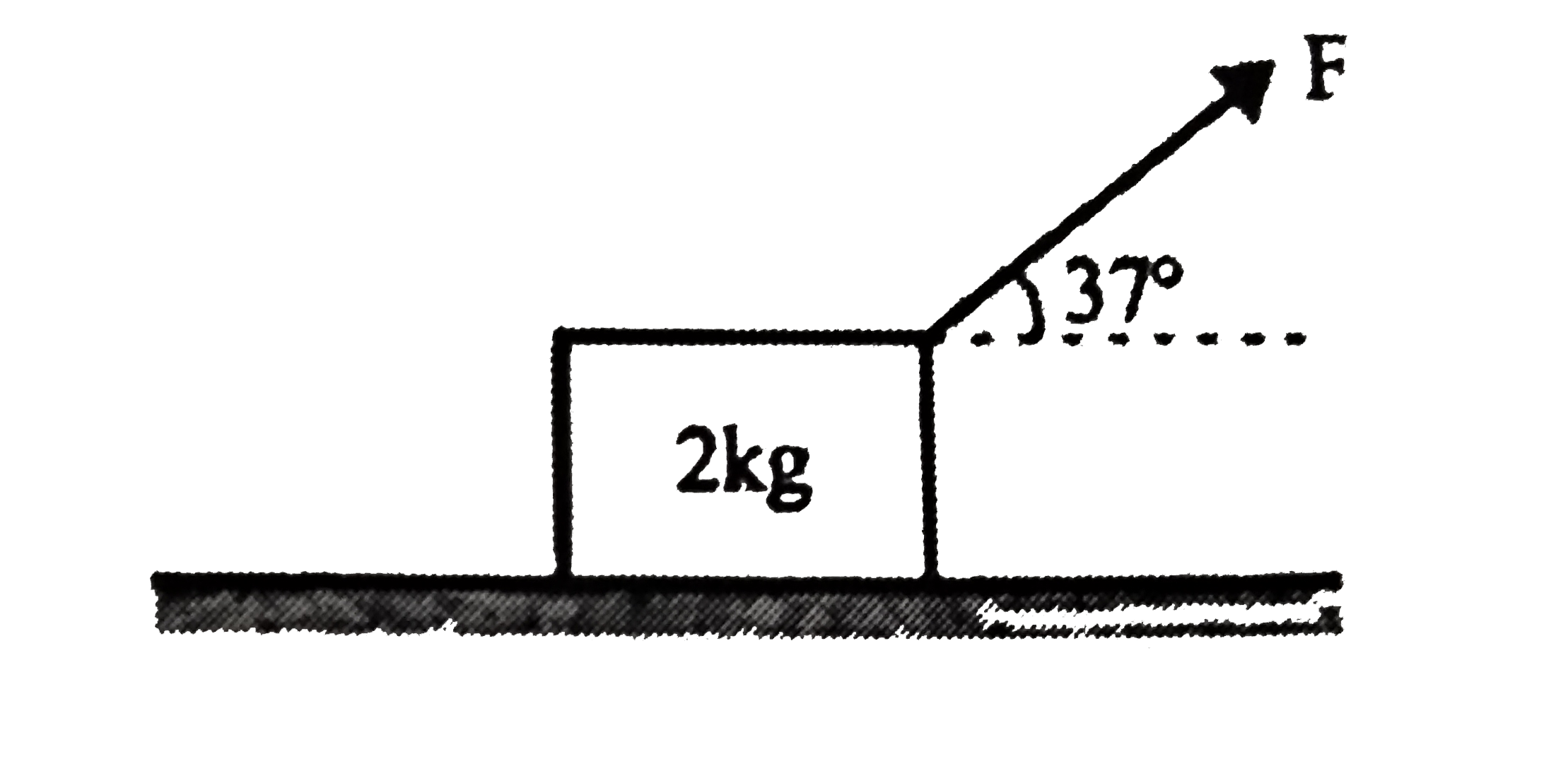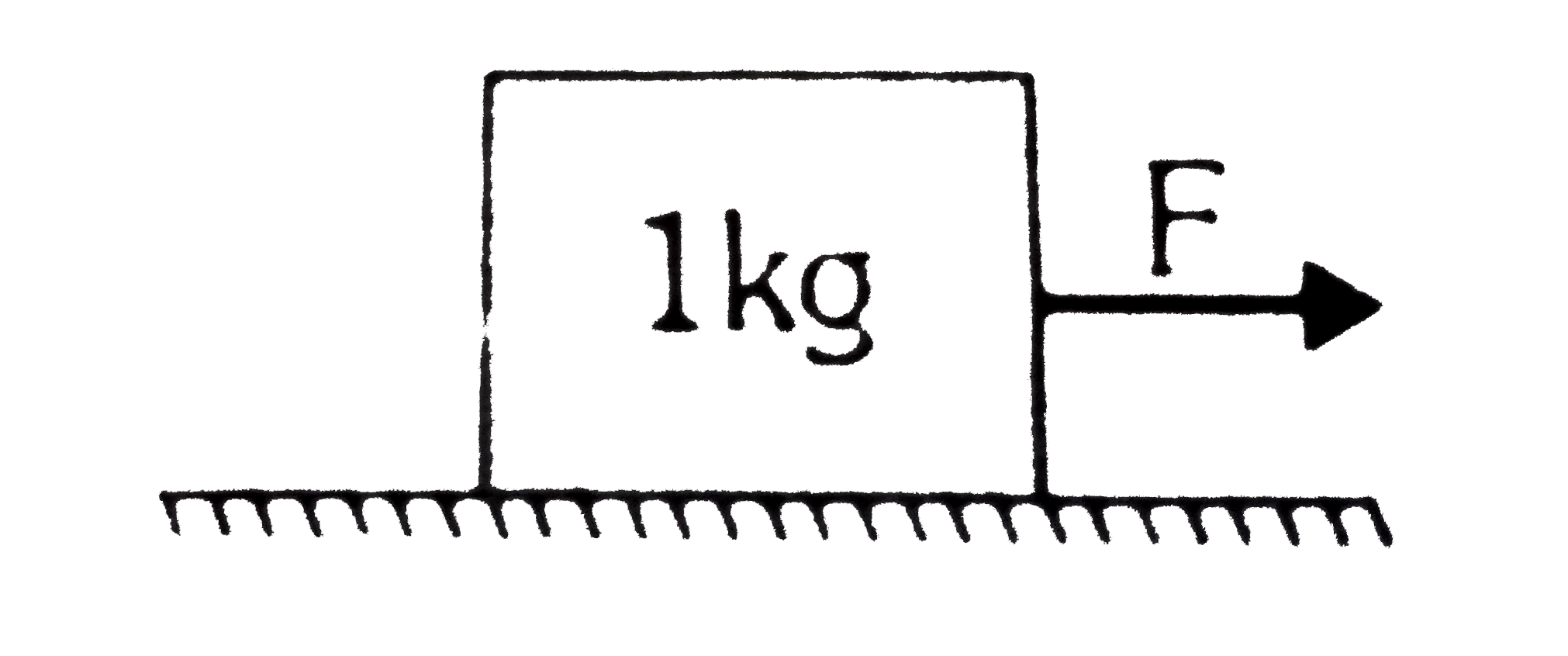A block of mass 2 kg is on a horizontal surface. The coefficient of static & kinetic frictions are 0.6 & 0.2 The minimum horizontal force required to start the motion is applied and if it is continued, the velocity acquired by the body at the end of the 2nd second is (g=10ms2)
8ms−1
4ms−1
2ms−1
zero
The correct Answer is:A
To solve the problem step by step, we will follow the outlined process below:
Step 1: Identify the Given Data
- Mass of the block, m=2kg
- Coefficient of static friction, μs=0.6
- Coefficient of kinetic friction, μk=0.2
- Acceleration due to gravity, g=10m/s2
Step 2: Calculate the Normal Force
The normal force N acting on the block is equal to its weight since it is on a horizontal surface:
N=mg=2kg×10m/s2=20N
Step 3: Calculate the Maximum Static Friction
The maximum static friction force fs that needs to be overcome to start the motion is given by:
fs=μs⋅N=μs⋅mg
Substituting the values:
fs=0.6⋅20N=12N
Step 4: Determine the Minimum Force Required to Start Motion
The minimum horizontal force F required to start the motion is equal to the maximum static friction:
F=fs=12N
Step 5: Calculate the Kinetic Friction Force
Once the block starts moving, the kinetic friction force fk acting on it is given by:
fk=μk⋅N=μk⋅mg
Substituting the values:
fk=0.2⋅20N=4N
Step 6: Calculate the Net Force Acting on the Block
The net force Fnet acting on the block after it starts moving is:
Fnet=F−fk=12N−4N=8N
Step 7: Calculate the Acceleration of the Block
Using Newton's second law, the acceleration a of the block can be calculated as:
a=Fnetm=8N2kg=4m/s2
Step 8: Calculate the Velocity After 2 Seconds
Using the equation of motion, the final velocity v after time t=2s can be calculated using:
v=u+at
where u (initial velocity) is 0 (since the block starts from rest):
v=0+(4m/s2⋅2s)=8m/s
Final Answer
The velocity acquired by the body at the end of the 2nd second is:
8m/s
- Mass of the block, m=2kg
- Coefficient of static friction, μs=0.6
- Coefficient of kinetic friction, μk=0.2
- Acceleration due to gravity, g=10m/s2
The normal force N acting on the block is equal to its weight since it is on a horizontal surface:
N=mg=2kg×10m/s2=20N
The maximum static friction force fs that needs to be overcome to start the motion is given by:
fs=μs⋅N=μs⋅mg
Substituting the values:
fs=0.6⋅20N=12N
The minimum horizontal force F required to start the motion is equal to the maximum static friction:
F=fs=12N
Once the block starts moving, the kinetic friction force fk acting on it is given by:
fk=μk⋅N=μk⋅mg
Substituting the values:
fk=0.2⋅20N=4N
The net force Fnet acting on the block after it starts moving is:
Fnet=F−fk=12N−4N=8N
Using Newton's second law, the acceleration a of the block can be calculated as:
a=Fnetm=8N2kg=4m/s2
Using the equation of motion, the final velocity v after time t=2s can be calculated using:
v=u+at
where u (initial velocity) is 0 (since the block starts from rest):
v=0+(4m/s2⋅2s)=8m/s
The velocity acquired by the body at the end of the 2nd second is:
8m/s
Similar Questions
The co-efficient of static & kinetic friction are 0.6 & 0.3 The minimum horizontal force required to start the motion is applied and if it is continued, the distance travelled by the body in 4 sec is (g=10 ms−2)
View SolutionA block of mass 5kg is lying on a rough horizontal surface. The coefficient of static and kinetic friction are 0.3 and 0.1 and g=10ms−2 The frictional force on the block is
View SolutionA block of mass 20kg is pushed with a horizontal force of 90N. If the coefficient of static & kinetic friction are 0.4 & 0.3, the frictional force acting on the block is: (g=10ms−2)
View SolutionA block of mass 2 kg is kept on a rough horizontal floor an pulled with a force F. If the coefficient of friction is 0.5. then the minimum force required to move the block is :-

View SolutionA block of mass 10kg is placed on a rough horizontal surface having coefficient of friction μ=0.5 . If a horizontal force of 100N is acting on it, then acceleration of the will be.
View SolutionA block of mass 10kg is placed on a rough horizontal surface having coefficient of friction μ=0.5 . If a horizontal force of 100N is acting on it, then acceleration of the will be.
View SolutionA block of mass 50kg rests on a rough horizontal plane whose coefficient of static friction is 0.3. What is the least force required to just move it if it is pulled (i) horizontally and (ii) at 45∘ to the horizontal.
View SolutionA block of mass 4 kg is kept on a rough horizontal surface. The coefficient of static friction is 0.8. If a forace of 19 N is applied on the block parallel to the floor, then the force of friction between the block and floor is
View SolutionA block of mass 20 kg is on a horizontal plane of a coefficient of friction 0.5. by applying 6.0 newton force on it, frictional force will be (g=10m/s2).
View SolutionA block of mass 1kg is at rest on a rough horizontal surface having coefficient of static friction 0.2 and kinetic friciton 0.15, find the frictional forces if a horizontal force,
(a) F=1N (b) F=1.96N (c) F=2.5N is applied on a block

View Solution
